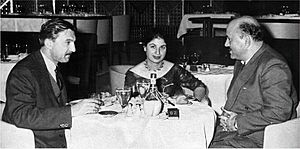Rifat Chadirji facts for kids
Rifat Chadirji (Arabic: رفعت الجادرجي Rifa'a al-Khādarjī; 6 December 1926 – 10 April 2020) was an Iraqi Turkmen architect. Many people called him the "father of modern Iraqi architecture." He designed over 100 buildings across Iraq.
Contents
Early Life and Education
Rifat Chadirji was born in Baghdad, Iraq, in 1926. His family was well-known. His father, Kamil Chadirji, was an important politician in Iraq.
Rifat studied to become an architect. After finishing his studies in 1952, he returned to Baghdad. He started working on what he called his "architectural experiments." He wanted to mix traditional Iraqi building styles with new ideas. He also wanted to make buildings that fit modern needs.
Chadirji called this way of designing international regionalism. This idea fit well with the goals of the Modern Baghdad Group. This art group started in 1951. Rifat was an early member. The group wanted to combine old Iraqi heritage with modern art and buildings. Their goal was to create a unique Iraqi style. They also hoped to influence art and architecture across Arab countries.
Designing Buildings in Iraq
Chadirji's early designs were inspired by the Baghdad Modern Art Group. This group included artists like Jawad Saleem and Mohammed Ghani Hikmat. Chadirji took ideas from old buildings and made them new. He used modern shapes and forms. Some people thought he was more of a modern architect.
His first projects were often rebuilding old homes. In 1959, he designed a big public monument. It was called The Monument to the Unknown Soldier. This monument was in Baghdad's Ferdous Square. It looked like an arch from an ancient Iraqi palace. The design showed a mother bending to pick up her child. This monument was later removed.
Chadirji often used old Iraqi ideas in his buildings. For example, his designs included ways to control temperature. He used natural air flow, courtyards, and special walls. These methods were common in traditional Iraqi buildings. He also used arches and strong pillars. These reminded people of Iraq's long history of architecture. Even when he used old ideas, he made them look new. Sometimes, his buildings looked traditional on the outside. But inside, they had European styles.
Challenges and Later Life
In 1978, Chadirji faced difficulties and was imprisoned. After nearly two years, he was released. The leader at the time, Saddam Hussein, wanted Chadirji's help. He wanted the best architect to plan for a big conference in Baghdad. Chadirji became an architectural advisor for Baghdad City Planning. This was from 1982 to 1983.
While he was in prison, he wrote a book. It was called Al Ukhaidir and the Crystal Palace. His wife helped him get materials for the book. This book is now seen as a very important work about Iraqi architecture.
In the 1980s, Chadirji helped oversee many building projects in Baghdad. In 1983, he left Iraq to teach at Harvard University. When he returned to Baghdad later, he was sad to see how the city had changed. He and his wife decided to move to London permanently. He lived there for the rest of his life.
Rifat and his father, Kamil Chadirji, took many photos. They documented buildings and places in Iraq and Syria. They worried that new construction would destroy these old structures. In 1995, Rifat published a book of his father's photos. His father's political role gave him special access to many places.
Notable Works
Chadirji designed many homes. But he is most famous for his public buildings and monuments. His Monument to the Unknown Soldier (1959) was a simple, modern design. It was later replaced by a statue of Saddam Hussein.
| Building Name | City | Country |
| Central Post Office (1975) | Baghdad | Iraq |
| Hamood Villa (1972) | Baghdad | Iraq |
| National Insurance Company | Mosul | Iraq |
| Offices and Tobacco Warehouses (1965) | Baghdad | Iraq |
| The Monument to the Unknown Soldier (1959) | Baghdad | Iraq |
| Rafiq Residence (1965) | Baghdad | Iraq |
Books by Rifat Chadirji
Chadirji wrote several books, mostly in Arabic. Some of them include:
- al-Ukhaidir and the Crystal Palace (1991)
- A Dialogue on the Structure of Art and Architecture (1995)
- Concepts & Influences: Towards a Regionalized International Architecture (1987)
- Internationalised Tradition in Architecture (1988)
Awards and Recognition
Rifat Chadirji received many awards for his work:
- 1964: Bronze Medal, Barcelona Furniture Design
- 1986: Chairman's Award of the Aga Khan Award for Architecture
- 2008: Sheikh Zayed' Book Award
- 2015: Honorary PhD from Coventry University
- 2015: Lifetime Achievement Award from Tamayouz Excellence Award
His Legacy
In 2017, the Rifat Chadirji Prize was created. This award honors architects who help rebuild parts of Iraq. It is part of the Tamayouz Award for Excellence.
Also in 2017, he gave his architectural drawings and his father's photo collection to the Aga Khan Documentation Center at MIT Libraries. This means his important work will be preserved for future generations.
Personal Life
In 1954, Rifat Chadirji married Balkis Shahara. He stopped working as an architect in 1982. After that, he focused on research and writing.
Rifat Chadirji passed away in London on 10 April 2020. He was 93 years old. Many important Iraqi leaders, like the prime minister and president, shared their sadness.
See also
 In Spanish: Rifat Chadirji para niños
In Spanish: Rifat Chadirji para niños
- Culture of Iraq
- Iraqi art
- Islamic art
- Islamic architecture
- List of Iraqi artists
- Tomb of the Unknown Soldier
Images for kids




